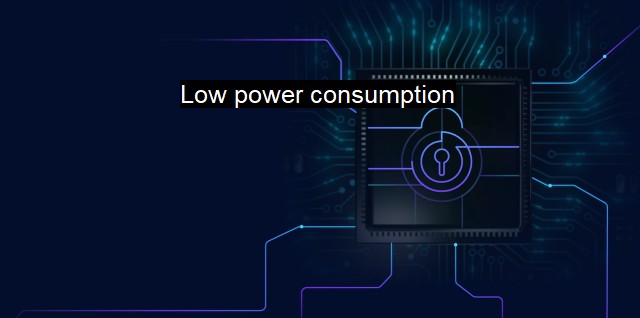What is Low power consumption?
The Importance of Low Power Consumption in Cybersecurity and Antivirus for Electronic Devices: Promoting Energy Efficiency and Protecting User Data
Low power consumption refers to the amount of energy that an electronic device uses while it operates at a low or energy-efficient level. The purpose of low power consumption is to reduce energy consumption in electronic devices such as laptops, mobile phones, and tablets. low power consumption devices also promote ecological sustainability, especially considering the ever-growing number of electronic devices in the world today.low power consumption is particularly essential for providing security and protection over the internet to devices with limited power supply. Cybersecurity has become a societal must-have since all devices are now connected to interconnected systems. Threat actors can exploit any vulnerability in the interconnected systems, putting user data information at risk.
The limited energy available for electronic devices automatically means the threat of communication breakdown due to energy depletion. In the case of cybersecurity, cyber threats have for long relied on devices' in-built vulnerabilities to circumvent security measures enforced on computer networks. Simple distributed attacks aiming several devices can also exhaust device energy requirements.
Antivirus, on the other hand, needs a certain degree of power capacity in any electronic device to deliver the cybersecurity services. Normally, individuals wishing to have antivirus will have to install an antivirus application, which automatically consumes some device sub-systems' utilities for it to become effective in run-time and mitigate cyber threats.
In theory, one necessary fix employed to spyware attack and low device security has been the development of low-power antivirus engines. The engines have helped to minimize hackers’ opportunities to act, concurrently maximizing energy consumption.
The plain explanation for the need to minimize energy usage or EUI attack methods is that hackers can subdue device functions, rendering the time-casting risk absolute. Hackers also use device heat, spillover-memory activities, and authorization within the attack lifecycle, ultimately experimenting with tool efficiency levels.
high device usage capacity can easily tell when suspicious activities such as network protocols fail happen within your device, and it is critical to low device maintenance. Cyber-securities using applications linked to a lower term power capacitance mostly branch from repelling techniques with attacking ciphertext, exploiting email-based attack spam or infested downloads.
Lastly, the conversation around low power consumption antivirus has leveraged European unified security sanctions programmed towards high-end digital services priority, which prioritize a security model broadening performance limitations across cloud engineering repositories. The adopted unified cybersecurity strategy on electric platforms, mostly covert risky rate-based power-driven prevention modeling machinery curated to best serve users coupled alongside and transitioning endpoints protection profiles across digital asset networks, especially those with limited energy capacity, which is the commonplace come-true solution.
developing low power consumption antivirus provides cost-effective security protocols and reduces the risk of energy depletion towards securing electronic devices. It promotes electronics sustainability coupled together while being ecological. New cybersecurity strategies have come up with increasingly branching cryptocurrencies and Artificial Intelligence protections engineered for ensuring digital asset platforms. In the future, low power consumption models will inevitably be better aligned alongside unsecured distinct identities through codes programming working machine learning auto encryption.

Low power consumption FAQs
What is low power consumption and how does it relate to cybersecurity and antivirus software?
Low power consumption refers to the amount of energy a device requires to function. In the context of cybersecurity and antivirus software, low power consumption can indicate that a program or device is less likely to be vulnerable to cyber attacks. This is because devices with lower power consumption typically have fewer hardware components and consume less power, reducing their susceptibility to certain types of malware that target specific hardware configurations.How can low power consumption contribute to longer battery life for devices running antivirus software?
Antivirus software running on a device can consume a significant amount of battery power. Devices with low power consumption are designed to use power efficiently, which can help prolong battery life. This means that devices with low power consumption can run antivirus software for longer periods without the need for frequent recharging, allowing for more consistent protection against cyber threats.What are some examples of low power consumption antivirus software?
There are many antivirus software programs available that prioritize low power consumption. Some examples include Avast Antivirus, Norton AntiVirus, and McAfee Antivirus. These programs are designed to run efficiently in the background while consuming minimal system resources. They are also equipped with advanced features that can help protect your device against a wide range of cyber threats.Are there any downsides to using low power consumption antivirus software?
While low power consumption antivirus software can be beneficial for conserving battery life and minimizing system resource usage, they may not offer the same level of protection as more resource-intensive programs. This is because low power consumption antivirus software may not have access to all of the same features and functionality as more robust programs. As a result, users may need to weigh the benefits of low power consumption against the level of protection they require for their specific needs.| | A | | | B | | | C | | | D | | | E | | | F | | | G | | | H | | | I | | | J | | | K | | | L | | | M | |
| | N | | | O | | | P | | | Q | | | R | | | S | | | T | | | U | | | V | | | W | | | X | | | Y | | | Z | |
| | 1 | | | 2 | | | 3 | | | 4 | | | 7 | | | 8 | | |||||||